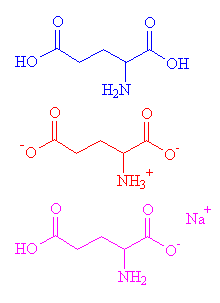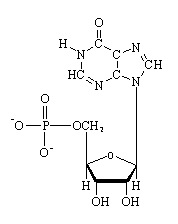
Monosodium glutamate is the sodium salt of glutamic acid, which is a naturally occurring amino acid. In aqueous solution, the acid reverts to its ionised form, and is known simply as glutamate. Glutamate plays a pivotal role in the biosynthesis of several key amino acids, and in fact, most of the non-essential amino acids (such as alanine and aspartine) derive their a-amino groups from glutamate.
 | The structures of glutamatic acid (blue), the ionised form, glutamate (red), in which it exists in biological systems, and monosodium glutamate (magenta).
|
As meat ages, the proteins it contains decompose to form a number of other substances, among them MSG and a breakdown product of ATP called inosine monophosphate (IMF). These two compounds together have a very pronounced meaty flavour, and are the principal components responsible for the taste of meat. Different meats contain MSG and IMF in different amounts, and so have different flavours. For example, the ratio of beef has two times as much MSG as pork (but about the same amount of IMF).
 | The structure of inosine monophosphate. |
Since MSG is much cheaper and more readily available than IMF, it is often added by food manufacturers to bring out the flavour of meat. This is especially true in the far East, such as China and Japan, where it is often used as an alternative to salt. The exact mechanism by which MSG enhances meat flavours isn't known, but it appears to increase the sensitivity of the salt and bitter taste receptors of the tongue.
Surprisingly, mushrooms also contain a large number of proteins which are composed of glutamic acid. This might account for their slightly meaty flavour and the fact that mushrooms are usually served with meat dishes.
Certain strains of bacteria (such as micrococcus and brevibacterium) excrete glutamic acid when fed an ammonium-rich diet. 'Fermentation' of ammonia in this way is now the standard commercial method for MSG production.